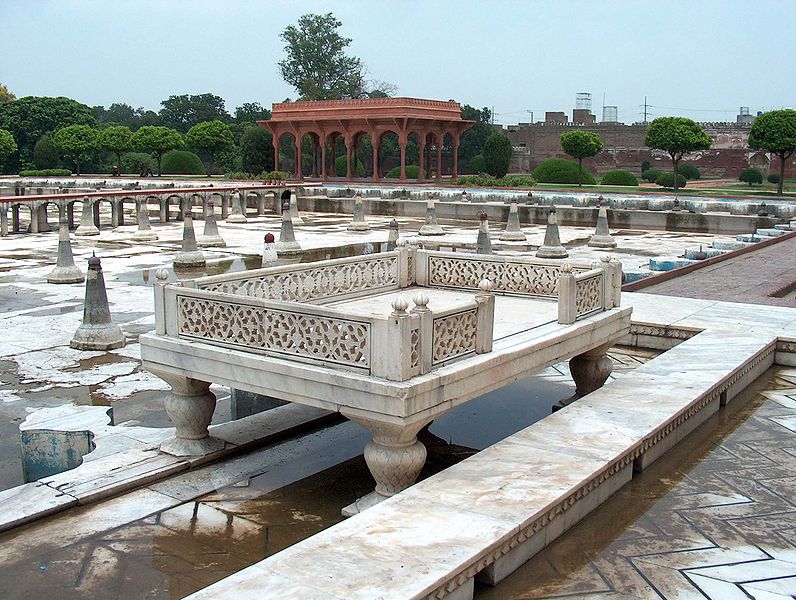The Shalimar Gardens (Punjabi, Urdu: شالیمار باغ), sometimes written Shalamar Gardens, is a Persian garden and it was built by the Mughal emperor Shah Jahan inLahore, modern day Pakistan. Construction began in 1641 CE (1051 AH) and was completed the following year. The project management was carried out under the superintendence of Khalilullah Khan, a noble of Shah Jahan's court, in cooperation with Ali Mardan Khan and Mulla Alaul Maulk Tuni. The Shalimar Gardens are located near Baghbanpura along the Grand Trunk Road some 5 kilometers northeast of the main Lahore city. There are five geographical sources of inspiration for Shalimar Gardens: Central Asia, Kashmir, West Punjab, Persia, and the Delhi Sultanate.They are not to be confused with the Shalimar Gardens (Jammu and Kashmir)
Architecture:-
The Shalimar Gardens are laid out in the form of an oblong parallelogram, surrounded by a high brick wall, which is famous for its intricate fretwork. This garden was made on the concept of Char Bhagh. The gardens measure 658 meters north to south and 258 meters east to west. In 1981, Shalimar Gardens was included as a UNESCO World Heritage Site along with the Lahore Fort, under the UNESCO Convention concerning the protection of the world's cultural and natural heritage sites in 1972.
Site History:-

Architecture:-
The Shalimar Gardens are laid out in the form of an oblong parallelogram, surrounded by a high brick wall, which is famous for its intricate fretwork. This garden was made on the concept of Char Bhagh. The gardens measure 658 meters north to south and 258 meters east to west. In 1981, Shalimar Gardens was included as a UNESCO World Heritage Site along with the Lahore Fort, under the UNESCO Convention concerning the protection of the world's cultural and natural heritage sites in 1972.
The three level terraces of the Gardens
The Gardens have been laid out from south to north in three descending terraces, which are elevated by 4–5 metres (13-15 feet) above one another. The three terraces have names in Urdu as follows:
- The upper terrace named Farah Baksh meaning Bestower of Pleasure.
- The middle terrace named Faiz Baksh meaning Bestower of Goodness.
- The lower terrace named Hayat Baksh meaning Bestower of life.
Shah Nahar : Irrigation of the Gardens
To irrigate the Gardens, a canal named Shah Nahar meaning Royal canal, later also known as Hansti nahar, meaning Laughing canal was brought from Rajpot (present day Madhpur in India), a distance of over 161 kilometers. The canal intersected the Gardens and discharged into a large marble basin in the middle terrace.
410 fountains
From this basin, and from the canal, rise 410 fountains, which discharge into wide marble pools. The surrounding area is rendered cooler by the flowing of the fountains, which is a particular relief for visitors during Lahore's blistering summers, with temperature sometimes exceeding 120 degrees fahrenheit. The distribution of the fountains is as follows:
- The upper level terrace has 105 fountains.
- The middle level terrace has 152 fountains.
- The lower level terrace has 153 fountains.
- All combined, the Gardens therefore have 410 fountains.
The Gardens have 5 water cascades including the great marble cascade and Sawan Bhadoon.
Buildings of the Gardens
The buildings of the Gardens include:
|
|
Trees of the Gardens
Some of the varieties of trees that were planted included:
|
|
| |
The site of the Shalimar Gardens originally belonged to one of the noble Zaildar families in the region, well known as Mian Family Baghbanpura. The family was also given the Royal title of 'Mian' by the Mughal Emperor, for its services to the Empire. Mian Muhammad Yusuf, then the head of the Mian family, donated the site of Ishaq Pura to the Emperor Shah Jahan, after pressure was placed on the family by the royal engineers who wished to build on the site due to its good position and soil. In return, Shah Jahan granted the Mian family governance of the Shalimar Gardens. The Shalimar Gardens remained under the custodianship of this family for more than 350 years.
In 1962, the Shalimar Gardens were nationalised by General Ayub Khan because leadingMian family members had opposed his imposition of martial law in Pakistan.
The Mela Chiraghan festival used to take place in the Gardens, until President Ayub Khanordered against it in 1958.

The Shalimar Gardens in Lahore







No comments:
Post a Comment